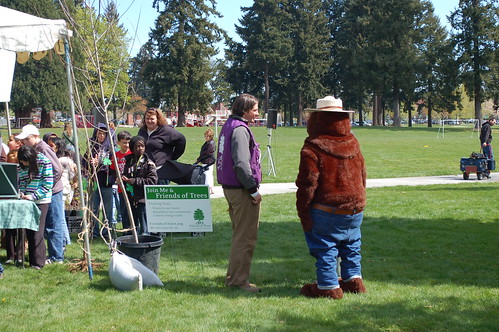Tag: elm
Help our elms this Saturday
Have you seen the little signs around town on some of our American Elms?
You’ve probably heard of Dutch Elm Disease. It has killed millions of trees around the world and taught urban foresters a tough lesson: Don’t plant too much of one tree species.
Many of these American Elms remain alive in Portland. One big reason is a nonprofit called Save Our Elms. They raise funds to inoculate trees every three years at a cost of $125-$175 for each tree (using volunteer labor).
This Saturday, you can volunteer to help save these majestic trees. Approximately 90 trees will receive treatment this year.
Inoculation has had a significant positive impact on saving the majestic American Elms that grace the Ladd’s Addition neighborhood. Contact Toby Deming at [email protected] to volunteer, or simply show up at the event.
Where & When
Saturday, June 26
8:00 a.m. to 12:30 p.m.
Elm Room, Palio
1996 SE Ladd Avenue
Agenda:
8:00 a.m. — Annual SOE meeting (optional for volunteers)
8:30 a.m. — Volunteers meet for orientation and instructions
9:00 a.m. — Inoculating begins
11:30 a.m. — Break for lunch
12:30 p.m. — Finish inoculating any remaining trees
Wear your gardening clothes and gloves. If you have pruners, please bring them.
For more information visit Save Our Elms.
Trees and power lines: A bad idea?

By Brighton West
Someone recently asked why Friends of Trees planted trees under power lines, implying that it was a bad idea. Not so if you follow the rule “Right Tree in the Right Place.”
Trees have different types of growing habits. We know that Doug-Firs have a strong central leader (the main trunk goes straight up), Accolade Elms don’t (their branches all spread out and create a vase shape), and Prairiefire Crabapples only grow about 20 feet tall.
Knowing these characteristics, we can select a tree that doesn’t grow tall enough to interfere with primary power lines—and thus won’t need to be pruned by the power company.
I don’t know of many people who like to look at overhead wires, so selecting a low-growing tree to grow underneath the primary lines can be a good way to screen these lines from eye level. And if the lines aren’t primary power lines, a tall-growing tree could be the most effective—but more about that in my next blog post.
Coming next Monday: Trees and Powerlines: When is it OK to plant a tall tree under power lines?
West is the programs director at Friends of Trees: [email protected]; 503-282-8846 ext. 19
Adopt a Heritage Elm at Saturday workshop
Portland Urban Forestry is holding a workshop Saturday tailored specifically to teach attendees how to monitor and care for the 300 Heritage Trees in Portland.
Certified arborists will teach the basics of tree health assessment and how to accurately measure height, canopy and circumference. The workshop will also give instructions on how to lead a ‘tree’ walk and how a neighborhood can ‘adopt’ a heritage elm.
Advanced registration is required for the workshop, which runs 9 a.m. to noon.
The majority of the workshop will be outdoors. The meeting place is the SMILE Station at 8213 SE 13th Ave.
Friends of Trees supplies five different species of elm trees, all resistant to Dutch Elm Disease.
–Toshio Suzuki
Vancouver celebrates 21 years as Tree City USA

By Jesse Batty
The city of Vancouver held its annual Arbor Day Celebration at the Mayor’s Grove April 14, continuing a commitment to the urban forest for many years to come.
The day consisted of a presentation of awards, tree games for kids, planting the mayor’s tree (Triumph Elm), and a Bigleaf Maple seedling giveaway for students.
Mayor Tim Leavitt, on hand to plant his commemorative tree, reminded the elementary students that when climbing trees, “remember that you have to get down!”
The celebration also saw the inaugural presentation of the Gordon MacWilliams Award, for those who have displayed excellence in preserving Vancouver’s urban forest.
Among the winners were Friends of Trees Neighborhood Coordinators Sue Sanders and Cynthia Thornton-Tang. Both have been amazing Neighborhood Coordinators with Friends of Trees and we congratulate them on their award!
Vancouver was presented with the designation of Tree City USA for the 21st straight year. For a full story of the event and photos, visit this story from The Columbian.
Batty is the Neighborhood Outreach Coordinator for Vancouver: 360-619-1127, [email protected]
More than a tree; friends for 50 years
This CBS news special aired last week and told the story of Herbie, the 240-year-old elm tree and Frank Knight, its 101-year-old caretaker.
–Toshio Suzuki

